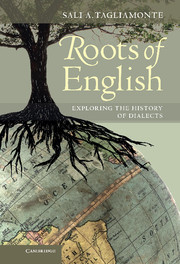Book contents
- Frontmatter
- Contents
- List of Figures
- List of Tables
- Preface
- Acknowledgements
- Abbreviations
- 1 Introduction
- 2 Dialects as a window on the past
- 3 The Roots Archive
- 4 Methods of analysis
- 5 Word endings
- 6 Joining sentences
- 7 Time, necessity and possession
- 8 Expressions
- 9 Comparative sociolinguistics
- 10 The legacy of British and Irish dialects
- Notes
- References
- Index
5 - Word endings
Published online by Cambridge University Press: 05 November 2012
- Frontmatter
- Contents
- List of Figures
- List of Tables
- Preface
- Acknowledgements
- Abbreviations
- 1 Introduction
- 2 Dialects as a window on the past
- 3 The Roots Archive
- 4 Methods of analysis
- 5 Word endings
- 6 Joining sentences
- 7 Time, necessity and possession
- 8 Expressions
- 9 Comparative sociolinguistics
- 10 The legacy of British and Irish dialects
- Notes
- References
- Index
Summary
Them times is not the same as now. … Them times was hard times.
(Kate McBridge, 88, CLB, 005)In this chapter I examine a number of variable features that involve word endings. Word endings are affixes, features that add grammatical meaning to a word, such as ‘plural’, ‘grammatical person’, etc. The study of words, word stems and affixes is referred to as morphology. Variation in morphology is a common feature of language. Endings may differ from one community to the next and there tends to be considerable variation as to whether the endings prescribed by Standard English grammar are present or not.
Note
A stem is a word to which affixes attach. A stem can be a simple word, e.g. cat + s = cats or a word that already has an affix attached to it, e.g. helpful + ness = helpfulness.
The history of the English language is at least partly to blame for the variation in endings in some situations. This is because English evolved from language contact with other languages at various times in its history, Germanic and Scandinavian varieties at the early stages and French from 1066, as well as dialect mixture between the north and the south (see, e.g., Wales , 2006 ). Let us see how variation in this area of grammar operates across the Roots Archive.
- Type
- Chapter
- Information
- Roots of EnglishExploring the History of Dialects, pp. 64 - 93Publisher: Cambridge University PressPrint publication year: 2012



